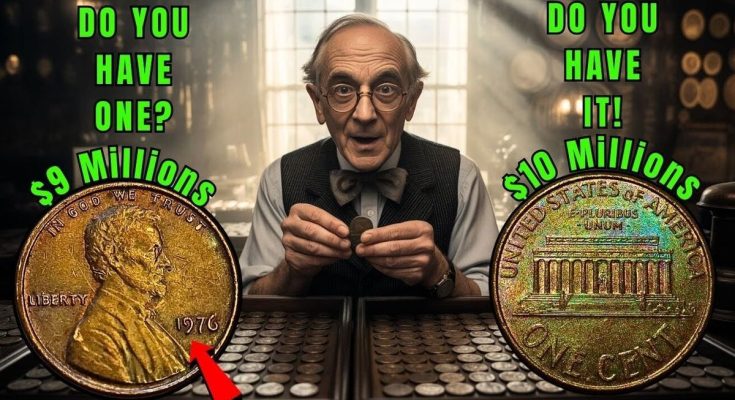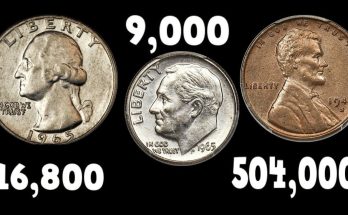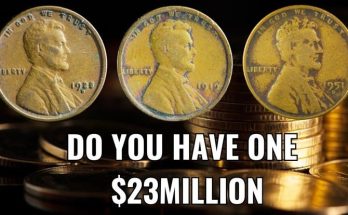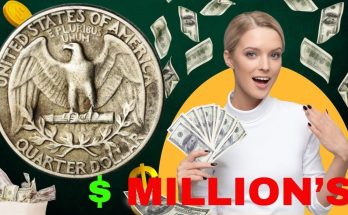💰 The Allure of Pocket Change: Could Your Penny Be a Fortune?
Caption: DO YOU HAVE THESE VERY EXPENSIVE PENNIES THAT COULD MAKE YOU A MILLIONAIRE!
The Million-Dollar Penny Myth vs. Reality
The captivating image before you promises a dream: that a single, unassuming copper cent from your spare change jar could be a winning lottery ticket worth millions. A $9 Million penny on the left and a $10 Million penny on the right—the figures are astonishing and, frankly, the stuff of numismatic legend. The truth, as any seasoned coin collector (numismatist) knows, is far more nuanced, exciting, and grounded in history and rarity. While the chances of finding a multi-million dollar penny in circulation are virtually zero, the possibility of possessing a coin worth thousands, or even hundreds of thousands, is very real, and that’s what fuels the thrilling hunt for rare U.S. cents.
The central figure in the image, an excited elderly man with glasses and a bow tie, perfectly embodies the excitement and fascination of coin discovery. He holds a coin, perhaps the one he believes is the coveted treasure, surrounded by trays of other cents, suggesting a serious collection or a dealer’s inventory. This setting—part antique shop, part dimly lit vault—enhances the feeling of uncovering a hidden secret.
What Makes a Penny Valuable? Understanding the Key Drivers
The inflated values advertised in the photo are intended to grab attention, but they hint at the genuine factors that propel certain coins into high-value territory. The worth of a rare coin is determined by a few crucial elements:
- Rarity (Mintage Figure): How many were originally produced? Coins with extremely low mintage numbers are inherently more valuable.
- Condition (Grade): The coin’s state of preservation. A coin graded as Mint State (MS) with no wear and excellent luster will command a significantly higher price than a worn example.
- Error or Variety: These are the holy grails. Coins struck with a mistake, such as a “Double Die” (where the design elements appear shadowed or duplicated), a wrong metal composition, or an incorrect mint mark, often become legendary.
The Famous Cents That Command Real Riches
While the generic 1976 cent shown in the image is not a known multi-million dollar error, its depiction allows us to discuss the cents that truly break the bank.
- The 1943 Copper Penny: During World War II, copper was vital for the war effort. The U.S. Mint famously switched the composition of the cent to zinc-coated steel. A handful of cents were accidentally struck on leftover copper planchets in 1943. These 1943 Copper Cents are one of the most famous and valuable error coins in U.S. history, with some selling for well over $200,000 and, in one exceptional case, nearly $1.7 Million.
- The 1944 Steel Penny: The reverse of the 1943 error, a few steel planchets slipped into the production of the 1944 cents, which were supposed to be made from salvaged shell casings (a modified copper alloy). These are also extremely valuable, often fetching tens of thousands of dollars.
- The 1955 Double Die Obverse: A prominent error where the date and lettering are clearly doubled. Because it was discovered early and widely publicized, it has become one of the most recognized and sought-after error coins, with high-grade examples selling for tens of thousands of dollars.
Starting Your Own Treasure Hunt
The lesson here is not to expect $10 million, but to understand that valuable treasures do exist in the world of pocket change. The thrill is in the search and the knowledge required to spot a genuine rarity.
When you look through your own change, focus on:
- Dates from the 1940s to the 1960s: These decades saw interesting composition changes and minting practices.
- The Lincoln Bust (Obverse): Look closely at the date, the word “LIBERTY,” and the motto “IN GOD WE TRUST” for signs of doubling or errors.
- The Memorial Reverse (Right Coin): Inspect the words “UNITED STATES OF AMERICA” and the columns of the Lincoln Memorial. The right coin in the photo shows an intriguing, almost rainbow-like toning, known as Toning or Patina, which can sometimes add significant appeal (and value) to a coin, especially if naturally occurring.
The chance of becoming a millionaire from a single penny is remote, but the joy of discovery, the connection to history, and the possibility of finding a coin worth hundreds or thousands of dollars makes every handful of change a potential treasure chest. Keep looking, and happy hunting!
Would you like me to search for the current market value of a known, actual high-value penny error, like the 1943 Copper Cent?



